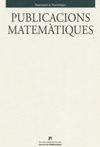Reverse Faber-Krahn inequality for a truncated Laplacian operator
IF 0.8
3区 数学
Q2 MATHEMATICS
引用次数: 2
Abstract
In this paper we prove a reverse Faber-Krahn inequality for the principal eigenvalue $\mu_1(\Omega)$ of the fully nonlinear eigenvalue problem \[ \label{eq} \left\{\begin{array}{r c l l} -\lambda_N(D^2 u) & = & \mu u & \text{in }\Omega, \\ u & = & 0 & \text{on }\partial \Omega. \end{array}\right. \] Here $ \lambda_N(D^2 u)$ stands for the largest eigenvalue of the Hessian matrix of $u$. More precisely, we prove that, for an open, bounded, convex domain $\Omega \subset \mathbb{R}^N$, the inequality \[ \mu_1(\Omega) \leq \frac{\pi^2}{[\text{diam}(\Omega)]^2} = \mu_1(B_{\text{diam}(\Omega)/2}),\] where $\text{diam}(\Omega)$ is the diameter of $\Omega$, holds true. The inequality actually implies a stronger result, namely, the maximality of the ball under a diameter constraint. Furthermore, we discuss the minimization of $\mu_1(\Omega)$ under different kinds of constraints.截断拉普拉斯算子的反Faber-Krahn不等式
本文证明了完全非线性特征值问题的主特征值$\mu_1(\Omega)$的逆Faber-Krahn不等式。这里$\lambda\N(D^2 u)&=&\mu u&\text{In}\Omega,\\u&=&0&\text{on}\partial\Omega.\end{array}\right。这里$\lambda_N(D^2 u)$代表$u$的Hessian矩阵的最大特征值。更确切地说,我们证明了,对于一个开的、有界的、凸的域$\Omega\subet\mathbb{R}^N$,不等式\[\mu_1(\Omega)\leq\frac{\pi^2}{[\text{diam}(\Ome茄)]^2}=\mu_1(B_{\text{diam}(\ Omega)/2}),\],其中$\text{diam}(\ Ome茄)$是$\Omega$的直径,成立。这个不等式实际上意味着一个更强的结果,即球在直径约束下的最大值。此外,我们还讨论了$\mu_1(\Omega)$在不同约束条件下的最小化问题。
本文章由计算机程序翻译,如有差异,请以英文原文为准。
求助全文
约1分钟内获得全文
求助全文
来源期刊
CiteScore
1.60
自引率
0.00%
发文量
29
审稿时长
>12 weeks
期刊介绍:
Publicacions Matemàtiques is a research mathematical journal published by the Department of Mathematics of the Universitat Autònoma de Barcelona since 1976 (before 1988 named Publicacions de la Secció de Matemàtiques, ISSN: 0210-2978 print, 2014-4369 online). Two issues, constituting a single volume, are published each year. The journal has a large circulation being received by more than two hundred libraries all over the world. It is indexed by Mathematical Reviews, Zentralblatt Math., Science Citation Index, SciSearch®, ISI Alerting Services, COMPUMATH Citation Index®, and it participates in the Euclid Project and JSTOR. Free access is provided to all published papers through the web page.
Publicacions Matemàtiques is a non-profit university journal which gives special attention to the authors during the whole editorial process. In 2019, the average time between the reception of a paper and its publication was twenty-two months, and the average time between the acceptance of a paper and its publication was fifteen months. The journal keeps on receiving a large number of submissions, so the authors should be warned that currently only articles with excellent reports can be accepted.

 求助内容:
求助内容: 应助结果提醒方式:
应助结果提醒方式:


